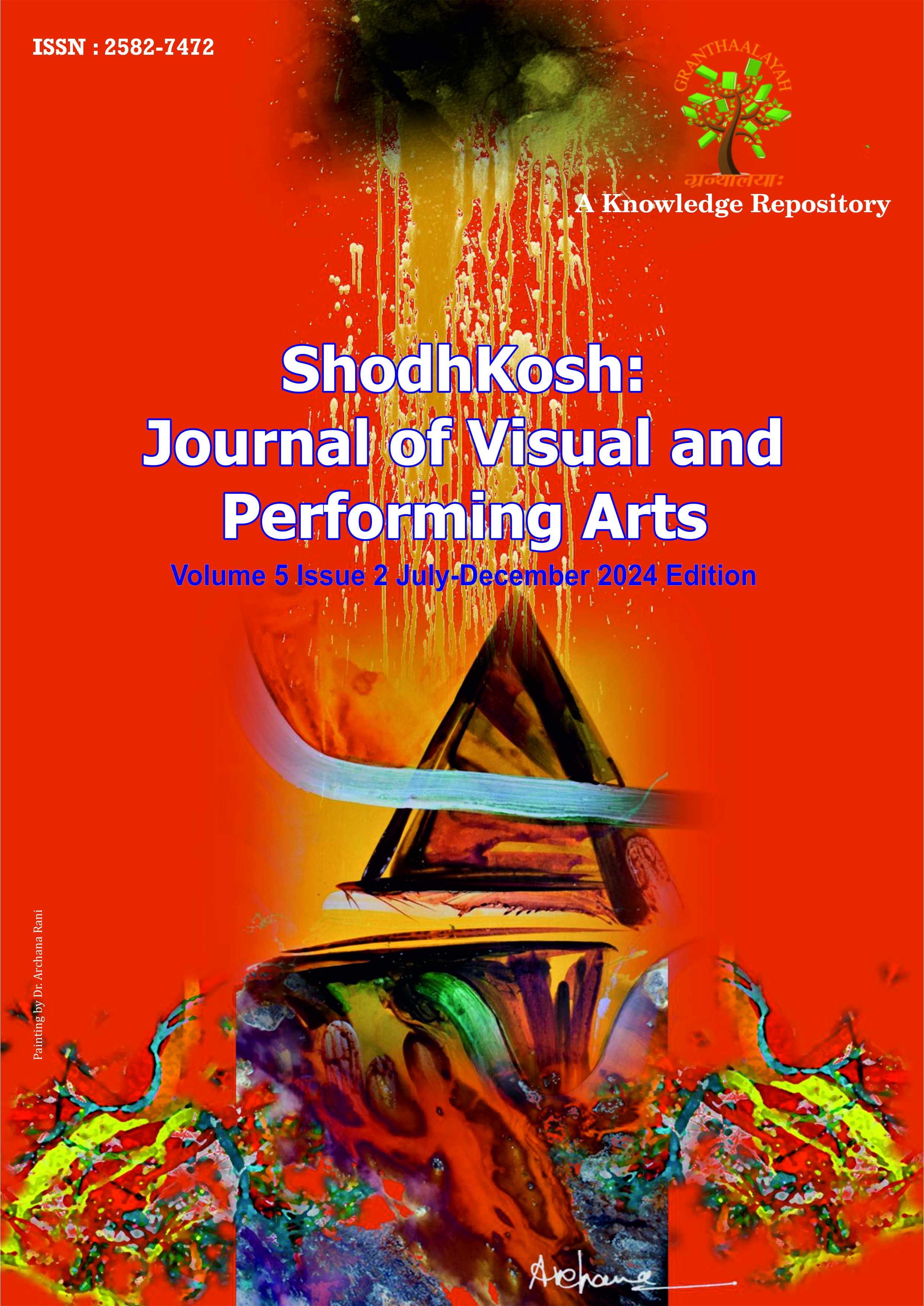ANALYSING GENDER ROLE PERCEPTIONS IN INDIAN TELEVISION ADVERTISEMENTS: A STUDY IN MATHURA, UTTAR PRADESH
DOI:
https://doi.org/10.29121/shodhkosh.v5.i2.2024.1061Keywords:
Advertising, Gender, India, Television, Perception, MathuraAbstract [English]
The purpose of the study is to comprehend the perceptions of young people regarding the images, roles and to know the changing trends regarding women and men's portrayal in various advertisements in Mathura region. This study's novelty lies in shedding light on the impact of culturally bounded aspects of advertising and perception of youth in Mathura. It also aims to highlight shifts in youth perceptions before and after exposure to these ads, urging advertisers to promote gender equality and reflect societal realities more accurately. The study was conducted with the school students in Mathura based on gender, age, and interests, Uttar Pradesh, India, to find their perceptions and opinions regarding the roles, trends and depictions of males and females in advertisements on television. This exploration is facilitated through a semi-structured questionnaire and a knowledge inventory test. The age of the young audience preferred for the study is between 15-19 years. To understand that what youth knows about the gender roles while watching ads on television and what are their perceptions on the images, roles and portrayals of women and men in the Indian television ads. The study initially collected data on viewers' perceptions of gender roles in selected Indian TV ads during prime time (8-9 pm). Two channels with the highest TRP were chosen, and six frequently aired ads were selected. A sample of 40 respondents, evenly split between genders aged 15-19, underwent a knowledge inventory test. Findings revealed stereotypical portrayals, with women mostly depicted in domestic roles and highly objectified. Men were shown as breadwinners and occasionally in domestic settings. This study also offers new critical insights into advertising that still employs gender stereotypes, such as gender roles mainly associated with men, implying that empowered women must behave like men.
References
Aruna., Kotwal, N., & Sahni, S. (2008). Perception of Adolescents Regarding Portrayal of Women in Commercial Advertisements on T.V. Journal of Social Science, 17(2), 121-126. DOI: https://doi.org/10.1080/09718923.2008.11892641
Arnaut, C. (2016). Gender and Advertising: perceptions of Marketing and Advertising students and professionals. Doi: 10.13140/RG.2.1.1723.8808.
Asadollahi, A., & Tanha, N. (2011). The Role of Television Advertising and Its Effects on Children. Interdisciplinary Journal of Research in Business, 1(9), 01- 06.
Bhagat, N. (2017). Emerging trend of Emotional Appeal in Indian Television Advertising. IOSR Journal of Humanities and Social Science, 22(8), 27-30. DOI: https://doi.org/10.9790/0837-2201022732
Bharadwaj, A., & Mehta, R. (2017). Annihilating or perpetuating the gender stereotype? An analysis of Indian television advertisements. DOI: https://doi.org/10.1007/s40622-017-0161-9
Das, M. (2016). Portrayal of Women in Indian Television Advertisements: An Exploratory Study. Published dissertation, Birla Institute of Technology and Science Pilani (Rajasthan).
Das, M., & Sharma, S. (2017). Perception of the Young Adults towards the Portrayal of Women in Contemporary Indian Television Advertisements. 8 (3) 339-354. DOI: https://doi.org/10.15655/mw_2017_v8i3_49147
Das, M. (2011). Gender Role Portrayals in Indian Television Ads. Sex Roles,208-222. DOI: https://doi.org/10.1007/s11199-010-9750-1
Eagly, H.A., & Mladinic, A. (1989). Gender Stereotypes and Attitudes toward Women and Men. Personality and social psychology bulletin, 15(4), 543-558. https://doi.org/10.1177/0146167289154008 DOI: https://doi.org/10.1177/0146167289154008
Fink, D.G., Fisher, E,D., Noll, M,A., Fisher, J,M.Television.
Grau, S.L., & Yorgos, C. (2016). Gender Stereotypes in advertising: a review of current research. International Journal of Advertising, 35(5), 761-770. DOI: https://doi.org/10.1080/02650487.2016.1203556
Jurčić, D., & Jurčić, I. (2016). Gender differences in advertising -misuse of women. 1(1), 47-56.
Kaushik, A.K., & Kaushik, K. (2012).Gender Gap in Literacy rate in Mathura district U.P.A Geographical Study. European Journal of Business and Social Sciences, 1(9), 95- 107.
Knoll, S., Eisend, M., & Steinhagen, J. (2011).Gender Roles in Advertising: Measuring and Comparing Gender Stereotyping on public and private TV channels in Germany. International Journal of Advertising, 30 (5). DOI: https://doi.org/10.2501/IJA-30-5-867-888
Lund, S., & Blaedon, L. (2003). Sex And The Media: The Impact Of Television Habits On Sexual Perception. UW-L Journal of Undergraduate Research VI, 1-6. DOI: https://doi.org/10.1037/e416902005-690
Moorthi, R, L, Y., Roy, S., & Pansari, A (2014). The Changing Roles Portrayed by Women in Indian Advertisements: A Longitudinal Content Analysis. DOI: https://doi.org/10.2139/ssrn.2391649
Muthu, U, T. (2018). Latest Trends in Television Advertising in India. Portrayal of Social Issues in Literature and Media, 18(6).
Rajagopal, A. (1993). The rise of national programming: the case of Indian television. Media, Culture & Society, 15(1), 91-111. https://doi.org/10.1177/016344393015001008 DOI: https://doi.org/10.1177/016344393015001008
Varghese, N., & Kumar, N. (2022). Feminism in advertising: irony or revolution? A critical review of femvertising. Feminist Media Studies, 22(2), 441-459. DOI: https://doi.org/10.1080/14680777.2020.1825510
Török, A., Gomez-Borquez, C. L., Centeno-Velázquez, E., & Malota, E. (2023). Empowerment through femvertising-Evidence from Mexico and Hungary. Feminist Media Studies, 1-18. DOI: https://doi.org/10.1080/14680777.2023.2268854
Parenthical Citations: Aruna, Kotwal, & Sahni, 2008; Arnaut, 2016; Asadollahi, & Tanha, 2011; Bhagat, 2017; Bharadwaj & Mehta, 2017; Das & Sharma, 2017;Das, 2011; Eagly & Mladinic 1989; Grau & Yorgos 2016, Jurčić & Jurčić, 2016, Kaushik & Kaushik 2012; Knoll, Eisend & Steinhagen, 2011; Lund & Blaedon, 2003; Moorthi, Roy, & Pansari, 2014, Muthu, 2018, Rajagopal, 1993; Varghese & Kumar, 2022; Török et.al, 2023.
Bhasin, k. (2003). Understanding Gender (6th Ed.). New Delhi: Women Unlimited.
Shah, K., & D’Souza, A. (2009). Advertising and promotions, an IMC Perspective (1st Ed.).
New Delhi. Tata McGraw Hill Education Pvt. Ltd.
Blackstone, M. Amy. (2003).Gender Roles and Society, 335-338.
Bordalo, P., Coffman, K., Gennaioli, N., & Shleifer, A. (2015). Stereotypes, 1- 73.Harvard University. DOI: https://doi.org/10.3386/w20106
Parenthical Citations: Bhasin, 2003; Shah & D’Souza, 2009; Balckstonse, 2003; Bordalo,
Coffman, Gennaioli, & Shleifer 2015.
Published
How to Cite
Issue
Section
License
Copyright (c) 2024 Dr. Sweta Suman, Reena Sharma

This work is licensed under a Creative Commons Attribution 4.0 International License.
With the licence CC-BY, authors retain the copyright, allowing anyone to download, reuse, re-print, modify, distribute, and/or copy their contribution. The work must be properly attributed to its author.
It is not necessary to ask for further permission from the author or journal board.
This journal provides immediate open access to its content on the principle that making research freely available to the public supports a greater global exchange of knowledge.




























